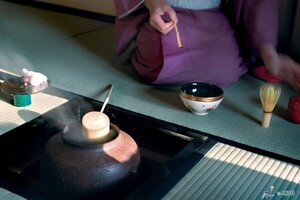
CLASSIC ARTS
Experience beauty and tradition.
-

Tea Ceremony
Japanese tea ceremony is considered an art form. It is very intricate, and takes a lifetime to master. It is performed based on zen Buddhism, and is said to prove to your guests while performing the ceremony that your acts and intentions are free of selfishness.
(Photo Copyright: ©JNTO)
-

Ikebana
Ikebana is a disciplined art form of flower arrangements. Artists will use several different materials for one arrangement and will follow strict rules of construction. The philosophical purpose is to develop a link with nature.
-

Origami
Ori or oru means "to fold," and gami or kami means "paper." Origami first started in the 6th century, when Buddhist monks first carried paper to Japan. The most famous design is the paper crane, and it is said that if you fold 1000 cranes, a wish for peace will come true.
-

Washi
Washi is a type of paper first made in Japan, and is usually made of tree bark. It requires cold water to make, and therefore traditionally it is made in the wintertime. Washi is used in many traditional arts, such as origami, calligraphy, and ukiyoe paintings.
(Photo Copyright: ©Saga Prefecture/©JNTO)
-

Calligraphy
Japanese calligraphy is called shodo, and originated from China. There are specific rules for each brush stroke: the most basic rule is to write from top to bottom, left to right.
(Photo Copyright:©Hiroshima Prefecture / ©JNTO)
-

Pottery
The earliest Japanese pottery is known to have started in the prehistoric Neolithic age. The designs were very simple until the 8th century when new glazing techniques were introduced from China. After that, other techniques were also introduced from Korea and Vietnam.
(Photo Copyright:©Kagoshima Prefectural Tourist Federation/©JNTO)
-

Lacquer
Japanese lacquer, or urushi, has been found to be in use as early as 7000 B.C. The product used for coating is extracted from tree sap which is very poisonous until it dries and is only allowed to be handled by experienced professionals. Urushi is often used on kitchenware, and sometimes traditional artifacts such as Buddha statues.
-

Kimono
A kimono is a traditional Japanese garment, and usually it is worn only on special occasions, mostly by women. The left collar must always come over the right, because in Japan, the opposite is done when dressing the dead for burial. A yukata is similar to a kimono, but is made with a much lighter fabric and is worn in the summertime.
(Photo Copyright:©City of Kyoto/©JNTO)
-

Koto
The Koto is a national instrument of Japan, and has 13 silk strings across a long wooden box. The player wears 3 plastic nails on their fingertips to be able to pluck these strings. The most famous song played on this instrument is called "Haru no Umi", and is often played on New Year's Day.
(Photo Copyright: ©JNTO)
-

Shamisen
The shasmisen is a three-stringed traditional instrument, similar to the shape of a guitar. A hand-held plectrum called a bachi is used to play the instrument. This instrument is often played in the background of traditional stage performances, or along with geisha dancers.
(Photo Copyright: ©Ishikawa Prefecture Tourist Association and Kanazawa Convention Bureau/© JNTO)


